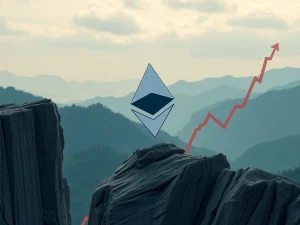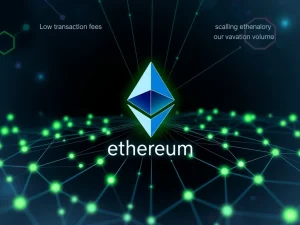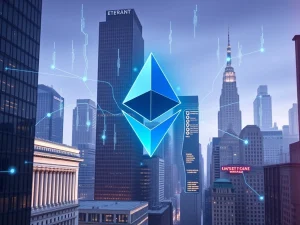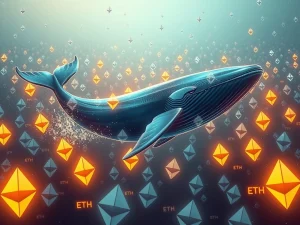Ethereum Developers See Remarkable Surge: Over 16K New Devs Join in Nine Months

The world of decentralized technology continues its rapid expansion. A significant influx of new talent highlights this growth. Specifically, Ethereum developers are flocking to the ecosystem in impressive numbers. This trend signals robust health and future potential for the leading smart contract platform. New data reveals a remarkable surge in crypto developer adoption, with Ethereum leading the charge.
Ethereum Leads in Crypto Developer Adoption
Between January and September of this year, the Ethereum ecosystem welcomed more than 16,000 new developers. This substantial increase positions Ethereum at the forefront of blockchain development. The Ethereum Foundation confirmed these figures, citing data from Electric Capital. This growth solidifies Ethereum’s position as the home to the largest active developer base across all blockchain projects. Currently, 31,869 developers actively contribute to the ecosystem. This number includes contributors to the Ethereum layer-1 network and various layer-2 solutions. These layer-2 networks, defined by L2Beat, include Arbitrum, Unichain, and Optimism, among others. Crucially, the data avoids double-counting developers who work across multiple networks within the same ecosystem. This ensures a precise count of unique contributors.
Solana’s Rapid Ascent and Developer Growth
While Ethereum maintains its lead, Solana has emerged as a formidable contender in attracting new talent. Solana secured the second spot for new developers. More than 11,500 developers began writing code for its ecosystem during the same nine-month period. However, a Solana Foundation representative noted that this data might be outdated, suggesting potentially higher current numbers. In terms of overall active developers, Solana ranks second with 17,708 contributors. Bitcoin, by comparison, saw nearly 7,500 new developers join its network, bringing its total active developer count to 11,036. Furthermore, Solana developer growth has been particularly impressive over longer periods. Full-time developers in the Ethereum ecosystem grew by 5.8% over the past year and 6.3% over two years. In stark contrast, Solana experienced a sharp 29.1% increase over the past year. Its two-year growth rate was a staggering 61.7%, according to Electric Capital’s developer tracker. This rapid expansion highlights Solana’s growing appeal to Web3 developers.
Unpacking Data Discrepancies and Definitions
The accuracy of developer metrics often sparks debate within the industry. Jacob Creech, head of developer relations at the Solana Foundation, believes Electric Capital’s data underreports Solana developers by approximately 7,800. Creech actively encourages developers to submit their GitHub repositories. This action helps Solana crawlers accurately track all Solana-related activity. Such efforts aim to provide a more comprehensive picture of the network’s developer engagement. Beyond Solana, other experts have questioned how data is categorized. Tomasz K. Stańczak, founder of Nethermind, argued that “EVM chains should be grouped together.” He explained, “Developers on Polygon and BNB clearly can reuse the majority of skills and EVM tooling.” This perspective suggests that a broader view of the Ethereum Virtual Machine (EVM) ecosystem might offer a more holistic understanding of blockchain development. Therefore, the way data is collected and categorized significantly impacts perceived growth and adoption trends across different platforms.
The AI Factor: Inflating Developer Numbers?
Amidst these impressive growth figures, some industry observers raise questions about potential data inflation. Jarrod Watts, head of Australia for the layer-2 network Abstract, expressed skepticism regarding the sheer number of new developers entering the space. Watts suggests that AI coding tools and numerous hackathon repositories might be skewing the figures. He stated, “IMO this data likely includes a tonne of vibe coding slop and hackathon repos that are never touched again.” Watts further added, “I don’t think I can name one new crypto dev that started this year.” This perspective introduces a crucial consideration: while raw numbers show growth, the quality and sustained engagement of these new contributors remain vital. The rise of AI in coding could certainly expedite development. However, it also complicates the precise measurement of genuine, long-term human Web3 developers. This ongoing discussion underscores the need for nuanced analysis when evaluating crypto developer adoption metrics. It ensures we understand the true state of talent within the ecosystem.
The Evolving Landscape of Blockchain Development
The influx of new Ethereum developers and the rapid expansion of the Solana ecosystem underscore a vibrant and competitive landscape. Despite debates over data accuracy and the influence of AI, the overall trend points to sustained interest in decentralized technologies. As blockchain development continues to mature, precise metrics become increasingly important. They help stakeholders understand where talent is gravitating. Furthermore, they inform strategic decisions for ecosystem growth. The continuous innovation across various platforms, from Ethereum’s robust Layer-2 solutions to Solana’s high-throughput network, promises an exciting future for Web3 developers. This dynamic environment encourages further competition and technological advancement. Ultimately, the health of these ecosystems relies on attracting and retaining skilled individuals. Therefore, understanding crypto developer adoption remains a critical indicator of long-term success in the blockchain space.









